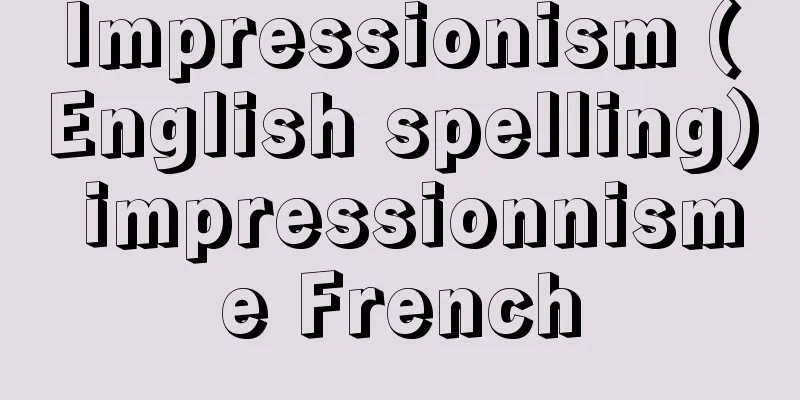Impressionism (English spelling) impressionnisme French

|
This refers to an artistic movement and style that took place mainly in France in the latter half of the 19th century. The painters who promoted this movement are collectively known as Impressionists. In the mid-19th century, the trend of positivism was strong in the fields of literature and thought in France, and in response to this, Courbet's realism began to rise to prominence in the art world from around 1850 onwards. The colours were dark or subdued, with an attitude of trying to depict visible things as they are. Manet and the early Impressionists inherited Courbet's ideas in terms of looking honestly at nature and rejecting historical and literary themes. However, they gradually became fascinated by the bright brilliance of colours, and were most strongly inspired to create by the ever-changing play of light and air in nature. They moved in a direction towards bright paintings, towards the analysis of the effects of light, and towards the depiction of the presence of air. In other words, Manet and the Impressionists started out in a positive objectivism, but moved towards a subjectivism that liberated their own individuality and sensibilities. As each painter's style developed and deepened, Impressionism produced an unprecedented golden age in the history of French art, marking the final stage of Western art based on realism, and at the same time exerted various influences on various trends in 20th century art. [Tadashi Ikegami] Early HistoryAround 1860 in Paris, Monet, Renoir, Sisley, Degas, Pissarro, and Cézanne became acquainted with each other. They all studied Courbet's realism and Delacroix's color, but at the same time, they felt strong dissatisfaction and doubts about the traditional academicism that dominated art schools and official exhibitions. When Manet's Luncheon on the Grass caused a scandal at the Salon des Refusés in the spring of 1863, they found important plastic revelations in this work, and naturally formed the Café Guerbois group (or the Rue des Batignolles group) with Manet at its center, and began to hold passionate debates about artistic innovation. Writers and critics such as Zacharie Astruc (1833/1835-1907), Zola, and Théodore Duret (1838-1927) also joined the group. Furthermore, influenced by the plein air paintings of Jongkind and Boudin, as well as the modern British landscape paintings that Monet and Pissarro saw in London, momentum for group exhibitions increased, but they were temporarily dispersed during the Prussian-French War in the summer of 1870. This was the preliminary stage to the establishment of Impressionism. [Tadashi Ikegami] Theory and MovementThe basic ideas of Impressionism were already seen in several works painted by Monet and Renoir at La Grenouillère near Bougival in 1869. These ideas included replacing light with color, using as many primary colors as possible to ensure the brightness of the picture plane, and striving to depict things without being bound by specific colors while paying attention to the shadows of objects, reflections on the water surface, and the ripples of water. These ideas and techniques were passed on by the two to Sisley and Pissarro, who in turn taught them to Cézanne. This was in 1872 and 1873. Thus the theory of "tone division" was born. The colors used on the picture plane were limited to seven colors that a prism divides light into, and these pure colors were painted as small spots instead of mixed colors, and complementary colors were juxtaposed to create a sharp effect. Adjacent colors blend together on the viewer's retina rather than on the palette, ensuring brightness and vividness on the picture plane. This is the idea of color division, which is sometimes called "visual blending" in accordance with the visual function of the viewer. Another theory is the "build-up" of paint. Conventional wisdom held that the surface of a finished oil painting should be smooth and viscous, like flowing oil, but this makes it difficult to express the subtle sparkle of light or the movement of the atmosphere. This point is all the more important since the Impressionists produced many landscape paintings. Therefore, they deliberately chose to leave the brushstrokes and the unevenness of the paint on the canvas as they were. This resulted in a complex and rough surface that stimulated the optic nerve, and the bright and dark areas naturally appeared in the details of the unevenness, enhancing the fresh sense of realism. However, it is important to note here that the Impressionists did not first establish a solid theoretical system and then apply it to their works; rather, the development of each individual's style and the deepening of their thoughts naturally led them to the theory mentioned above. The most important foundation on which their imaginative work was based was not theory, but rather the sensation derived from careful observation of nature. However, the more innovative the Impressionist theories and techniques, the more difficult it was for their works to be understood by the public. They submitted works to the Salon but were not always accepted, and many of the judges were adherents of old-fashioned neoclassical academicism. So Monet, Renoir, Pissarro, and Degas conceived their own group exhibition and organized the "Anonymous Society of Painters, Sculptors, and Printmakers," adding not only Sisley, Cézanne, and Guillaumin, who shared a common style with them, but also Jean-François Raffaeli (1850-1924) and Giuseppe De Nittis (1846-1884), who shared their anti-Salon attitude. Eight group exhibitions were held in Paris in 1874, 1876, 1877, 1879, 1880, 1881, 1882, and 1886, and the number of members exceeded 50. Among the artists who declined to join despite repeated invitations were Manet and James Tissot (1836-1902). The three most enthusiastic promoters of the movement were Pissarro, Degas, and Renoir, and the six main members were Monet, Cézanne, and Sisley, who were central figures in the style. The name "Impressionists" was derived from Monet's Impression, Sunrise, which he exhibited at the first exhibition, and they adopted it as the name of their group at the third exhibition, but Degas preferred the name "Intransigent Independents." Many Impressionists were landscape painters who painted rural or urban scenes, while Degas focused on people and painted modern urban scenes. Renoir painted landscapes, people, and genre scenes in roughly equal proportions, and both Cézanne and Renoir produced numerous bathing scenes. The group's homogeneity of style and maturity of style was most evident at the Third Exhibition, where Renoir exhibited "Moulin de la Galette" and Cézanne exhibited "Portrait of Choquet." [Tadashi Ikegami] Towards a progressive resolutionAround 1880, the Impressionists were around 40 years old. This was a time when they moved towards deepening their own art rather than engaging in collective activities. Originally, the Impressionist exhibitions were held at the same time as the Salon, and members had promised not to apply to the Salon, but Cézanne, Sisley, Renoir, Monet and others applied to the Salon one after another around this time, which greatly stimulated Degas's uncompromising spirit. As a result, Monet, Renoir and Cézanne did not participate in the 5th exhibition, and conversely Degas, Cassatt and Raphael did not participate in the 7th exhibition, showing a lack of unity within the group. As it involved concerns about their livelihood and whether or not they would be socially recognized, this internal division was an extremely serious problem, and since the pursuit of individual expression was their greatest concern, there was naturally a limit to their activities as a group. On the other hand, there was also the aspect of the participation of new members such as Gauguin, Seurat, Signac and Redon. Although they were by no means pure Impressionists, they were influenced by them and rebelled against them, while pioneering their own realm of painting. Moreover, Impressionist exhibitions were, for better or worse, group exhibitions, so there were some restrictions associated with this. In 1884, the Salon des Indépendants was born, under the slogan "no judging, no prizes," as a forum for presenting more advanced works, and in 1885 and 1886, Seurat's Neo-Impressionism was established as a more rigorous theoretical approach to Impressionism. However, neither of these could have been created without the great Impressionist movement, and in that sense the activities of the Impressionists were groundbreaking events in modern Western art. Furthermore, impressionist characteristics can be found in the novels of Goncourt and Proust, the music of Debussy, the sculptures of Rodin, and the poetry of Mallarmé. The influence of Impressionism also spread to Germany, Northern Europe, Britain, America, and other countries sooner or later. It is no exaggeration to say that modern French Impressionism is as important as the Italian Renaissance. Incidentally, the Impressionist style is not completely unprecedented in the past; a certain stage of ancient Roman painting that remains in places such as Pompeii is sometimes called the Impressionist style. [Tadashi Ikegami] neo-impressionismneo-impressionismeThe influence of Impressionism gradually spread to Europe and America from the 1880s onwards, and at the same time in France Georges Seurat advocated Neo-Impressionism. This was a more theoretical development of the ideas and techniques that Impressionism had established intuitively and empirically, and owed much to the optical and chromatic research of Chevreul, Helmholtz, Charles Henry (1859-1926) and others. Neo-Impressionism was also called divisionnisme because it thoroughly divided tones, and pointillisme because paint was applied as small round dots. However, the term pointillism is not appropriate for Neo-Impressionism, as it does not include the meaning of division of tones. After Seurat's death, Signac maintained the position of Neo-Impressionism for the rest of his life. Others include Henri Cross (1856-1910) and Albert Dubois-Pillet (1846-1890), and Pissarro, Van Gogh, Gauguin, and early Matisse were also temporarily influenced by this school. Seurat and Signac mainly exhibited their works at the Impressionist and Independants exhibitions. While Duret, Durant, Zola, and Mallarmé were among the critics who defended Impressionism, Félix Fénéon (1861-1944) was an important debater of Neo-Impressionism. [Tadashi Ikegami] post-impressionismThe term originates from the exhibition "Manet and the Post-Impressionists" organized by British critic Roger Fry in London in 1910-1911. It is a vague term referring to great painters who were different from the Impressionists and Neo-Impressionists and had a great influence on later generations, mainly referring to Cezanne, Gauguin, and Van Gogh. Cezanne was one of the main members of the Impressionists, and the other two were also influenced by Impressionism, and after assimilating it, developed more individualistic art. The three of them never started any kind of movement. Therefore, although the term is ambiguous, it is convenient and mainly used in English-speaking countries. In recent years, John Rewald (1912-1944) has used it to refer to painters mainly from the Salon des Indépendants lineage, including Neo-Impressionists, Redon, and the Nabis. [Tadashi Ikegami] Impressionism in JapanFrom the 1880s onwards, the influence of Impressionism spread around the world, both as a style and as a modern art movement. Japan was also at the stage of trying to absorb Western painting using oil paints at that time, and this influence was brought about by the return to Japan (1893) of Kuroda Seiki and Kume Keiichiro, who happened to have studied painting in Paris. However, both of them studied at the École des Beaux-Arts in Paris and received academic instruction from Raphaël Collin and others, and did not come into direct contact with Impressionist painters or their works. Although the two brought to Japan the gentle, eclectic, and somewhat impressionistic style of French Academicism, they still surprised people with the brightness of their paintings, the freedom of their sensibility, and the boldness of their choice of subject matter, and they were described as the "purple school" in contrast to the traditional "fat school" and as the new school in contrast to the old school. In the field of modern prints, Kobayashi Kiyochika's work is noteworthy for its fresh impressionist sensibility. Around 1900 (Meiji 33), Hayashi Tadamasa (1853-1906) sent a number of impressionist works to Japan. As Kuroda became the first professor of Western painting at the Tokyo School of Fine Arts and organized the Hakuba-kai (White Horse Society), his eclectic style came to dominate the Japanese Western painting world, but it soon lost its originality and showed its negative side by falling into formalism. Overall, however, this could be said to have been the fate of the rapid modernization of the Meiji period. [Tadashi Ikegami] "John Rewald History of Impressionism (1973, Museum of Modern Art, New York)" ▽ "Fabry Edition World Art Impressionist Painters" 12 volumes (1975-1976, Shogakukan)" ▽ "Commentary by Pierre Courtillon, translated by Toshio Yamanashi, "World Masters Series Supplementary Volume Impressionism" (1985, Bijutsu Shuppansha)" 1872 Oil painting , Metropolitan Museum of Art Sisley's The Bridge at Villeneuve-la-Garenne... 1884-1886 Oil painting , owned by the Art Institute of Chicago Seurat's "A Sunday on the Island of La Grande Jatte" 1874-1875 Oil painting , Metropolitan Museum of Art Cezanne "Bathers" 1874 Oil painting , Metropolitan Museum of Art Degas "The Dance Lesson" 1899 Oil painting , Metropolitan Museum of Art Pissarro, "The Tuileries Garden on a Winter Afternoon" 1892 Oil painting , Metropolitan Museum of Art Boudin's "Beaulieu Fourmi Bay" 1890-1891 Oil painting , owned by the Art Institute of Chicago Monet's "Haystacks, Late Summer" 1865 Oil painting , Metropolitan Museum of Art Jongkind "Honfleur" 1881 Oil painting (Collection of the Art Institute of Chicago ) Renoir "On the Terrace (Two Sisters)" Source: Shogakukan Encyclopedia Nipponica About Encyclopedia Nipponica Information | Legend |
|
19世紀後半にフランスを中心に行われた美術上の運動および様式をいう。これを推進した画家たちは印象派と総称される。19世紀なかば、フランスの文芸や思想の分野では実証主義の風潮が強く、これを受けて美術界でも1850年ごろ以降クールベの写実主義が頭角をもたげつつあった。可視的なものをあるがままに描写しようとする態度で、色彩は暗く、あるいは渋い。自然をすなおに見つめ、歴史的・文学的な主題を否定する点で、マネも初期の印象派たちもクールベの主張を受け継いだ。だが、彼らはしだいに色彩の明るい輝きに魅せられ、自然のなかの光と空気の変幻きわまりない戯れに、もっとも強く創作意欲を刺激されることになった。明るい絵画へ、光の効果の分析へ、空気の存在感の描写へ、という方向である。換言すれば、マネと印象派は実証的な客観主義に出発しながら、自己の個性や感性を解放する主観主義へと向かったことになる。各画家の画風の進展深化とともに、印象主義はフランス美術史上空前の黄金時代を生み出し、写実を基礎とする西洋美術の最終段階を形成し、同時に20世紀美術の諸傾向にもさまざまな作用を及ぼすこととなった。 [池上忠治] 前史1860年ごろのパリで、モネ、ルノワール、シスレー、ドガ、ピサロ、セザンヌらが相次いで知己となり、いずれもクールベの写実とドラクロワの色彩を学び、他方では美術学校や官展を支配する伝統的なアカデミズムに強い不満と疑問を感じていた。たまたま1863年春の落選者展でマネの『草上の昼食』がスキャンダルを巻き起こすと、彼らはこの作品に重要な造形的啓示を読み取り、おのずからマネを中心とするカフェ・ゲルボアのグループ(またはバチニョル街の集い)が形成され、芸術革新についての熱心な論議が闘わされるようになった。アストリュクZacharie Astruc(1833/1835―1907)やゾラ、デュレThéodore Duret(1838―1927)といった作家、批評家が加わることもあった。さらにはヨンキントやブーダンの外光主義、戸外制作の作用やモネとピサロがロンドンで見た近代イギリス風景画の影響も加わり、グループ展開催の気運も高まるが、1870年夏のプロイセン・フランス戦争で彼らは一時的に四散してしまうことになる。これが印象派成立の前段階である。 [池上忠治] 理論と運動印象主義の基本的な考え方はすでに1869年、モネとルノワールがブージバル近くのラ・グルヌイエールで描いた何点かの作品にみられる。光を色彩に置き換えること、可能な限り原色を多用して画面の明るさを確保すること、物の影や水面の反映、水の揺らめきなどに注目しつつ固有色にとらわれない描写に努めること、などである。こうした考え方と技法が2人からシスレーやピサロに伝えられ、ピサロからセザンヌにも教えられてゆく。1872、1873年のことである。こうして「色調分割」という理論が生まれる。画面に用いる色彩をプリズムが光を分割する7色に限定し、混色を避けてこれらの純粋色を小さな斑点(はんてん)として塗り、わけても補色関係にある色彩を並置してさえざえとした効果をねらう。隣り合う色彩どうしはパレットにおいてではなく見る者の網膜の上で溶け合うので、画面では明るさや鮮やかさが確保される。これが色彩分割の考え方であり、絵を見る者の視覚の働きに即して「視覚混合」といわれることもある。もう一つの理論は絵の具の「盛り上げ」である。従来の常識では、完成された油絵の表面は油を流したように、とろりと平滑でなければならないとされていたが、それでは光のきらめきや大気の揺れ動きの微妙さを表現しにくい。印象派が風景画を多作するだけにいっそうこの点は重要である。そこで彼らはあえて筆触や絵の具の凹凸をそのまま画面に残す方向をとった。これによって画肌(えはだ)は複雑にざらついて視神経を刺激する力を増し、凹凸の細部におのずから光る部分と暗い部分が生じて新鮮な臨場感をも高める結果となる。ただし、ここで留意しておく必要があるのは、印象派がまず確固たる理論体系を樹立してからこれを作品に適用したのではないこと、むしろ個々人の作風の展開と、思索の深化が自然と前記のような理論に行き着く運びとなったことである。創意あふれる彼らの作品の拠(よ)ってたつもっとも重要な基盤は理論ではなく、あくまでも自然の注意深い観察から引き出されるサンサシオンsensation(感覚の働き)なのである。 しかし印象派の理論や技法が革新的であればあるほど、その作品は世人の理解を得にくいことになる。彼らはサロンに応募するがかならずしも入選せず、審査員の多くは旧態依然たる新古典主義的なアカデミズムを信奉していた。そこで、モネ、ルノワール、ピサロ、ドガらは自分たちのグループ展を構想し、様式上の共通性をもつシスレー、セザンヌ、ギヨーマンのみならず、反サロン的な態度に共鳴するラファエリJean-François Raffaeli(1850―1924)、デ・ニッティスGiuseppe De Nittis(1846―1884)らをも加えて「画家、彫刻家、版画家の無名協会」を組織した。グループ展は1874年、1876年、1877年、1879年、1880年、1881年、1882年、そして1886年と計8回パリで開催され、会員数は50人を超えた。たび重なる勧誘にもかかわらず参加を断った画家に、マネとティソJames Tissot(1836―1902)がいた。運動をもっとも熱心に推進したのはピサロ、ドガ、ルノワールの3人で、これに様式上の中心的存在をなすモネ、セザンヌ、シスレーを加えた6人が主要なメンバーであった。「印象派」という呼称は、モネが第1回展に出品した『印象―日の出』に由来し、第3回展では彼らがこれをグループ名として採用したが、ドガは「非妥協的独立派」という名のほうを好んでいた。印象派には田園ないしは都会を描く風景画家が多く、これに対してドガは人物を中心として近代的な都会風俗を描いた。ルノワールは風景と人物、風俗をほぼ等分に描き、またセザンヌとルノワールは水浴図をも多作した。グループの様式上の等質性と作風の円熟がもっともよくみられたのは、ルノワールが『ムーラン・ド・ラ・ギャレット』を、セザンヌが『ショケ像』を出品した第3回展においてであった。 [池上忠治] 発展的解消へ1880年ごろ印象派の人々は40歳前後になる。集団的活動よりは自己の芸術を深める方向へ進む時期である。もともと印象派展はサロンと同時期に開催され、会員はサロンに応募しないという約束だったが、セザンヌ、シスレー、ルノワール、モネらがこのころ相次いでサロンに応募し、ドガの非妥協的な精神をいたく刺激した。そのため第5回展にはモネやルノワール、セザンヌが不参加、逆に第7回展ではドガやカサット、ラファエリが不参加というグループ結束の不統一がみられた。生活の不安と社会的な評価の有無が絡むだけに、こうした内部分裂はきわめて深刻な問題であり、また個性的表現の追求が最大の関心事であるため、元来グループとしての活動にはおのずから限界がある。他方では、ゴーギャン、スーラ、シニャック、ルドンら新会員の参加という側面もある。彼らはけっして純然たる印象派ではないが、これに影響されたり反発したりしながら画境を開拓していた。また、印象派展はよくも悪くも団体展なので、これにかかわる制約もなくはなかった。そこで1884年には「無審査、無賞」を旗印とするアンデパンダン展がより進んだ作品発表の場として誕生し、さらに印象主義の理論的側面をより厳密化したものとして、1885、1886年にスーラの新印象主義が成立するに至った。だが、これら両者はいずれも印象派の大運動なしには生まれえなかったはずのもので、その意味でも印象派の活動は近代西洋美術における画期的なできごとだった。さらに付け加えるならば、ゴンクールやプルーストの小説、ドビュッシーの音楽、ロダンの彫刻、マラルメの詩などにも印象主義的な特質を認めることができる。またドイツや北欧、イギリスやアメリカなどにも印象派の影響は遅かれ早かれ広まってゆく。近代フランスの印象主義はイタリア・ルネサンスに匹敵するほどの重要性をもつといっても、過言ではなかろう。 なお、印象主義的な作風は過去にまったく類例がないわけではなく、ポンペイなどに残る古代ローマ絵画のある段階を印象主義的様式とよぶこともある。 [池上忠治] 新印象主義néo-impressionnisme印象主義の影響は1880年代以降すこしずつ欧米に広まってゆくが、同じころフランスではジョルジュ・スーラが新印象主義を唱えた。これは印象派が直観的、経験的に樹立した考え方や技法をより理論的に推し進めたもので、シュブルール、ヘルムホルツ、シャルル・アンリCharles Henry(1859―1926)らの行った光学研究、色彩研究に多くを負っている。新印象主義は色調分割を徹底的に行うので分割主義divisionnismeともよばれ、また絵の具を小さな丸い斑点として塗るので点描主義pointillismeといわれることもあった。だが点描といういい方は、色調分割の意味を含まない点で新印象主義をさすには適当でない。スーラの死後はシニャックが終生この新印象主義の立場を堅持した。ほかにはクロスHenri Cross(1856―1910)や、デュボワ・ピエAlbert Dubois-Pillet(1846―1890)らがあり、ピサロ、ゴッホ、ゴーギャン、初期のマチスらも一時的にこの影響を受けた。スーラとシニャックの作品発表の場は主として印象派展とアンデパンダン展だった。印象主義を擁護した批評家としてデュレ、デュランチ、ゾラ、マラルメらがあったのに対して、新印象主義の論客としてはフェリクス・フェネオンFélix Fénéon(1861―1944)が重要である。 [池上忠治] 後期印象主義post-impressionismイギリスの批評家ロジャー・フライが1910~1911年にロンドンで催した「マネと後期印象派」展に由来する呼称。印象派や新印象派とは異なる大画家で後世に多大な影響を及ぼした人々という程度の漠然としたことばで、おもにセザンヌ、ゴーギャン、ゴッホの3人をさすが、セザンヌは印象派の主要メンバーの1人だし、残る2人も印象主義の洗礼をひとたび受け、そしてこれを消化してより個性的な芸術を開拓している。もとより3人がなんらかの運動を行ったこともない。したがって、これは語義のあいまいなことばだが、便利なこともあるので主として英語圏で用いられている。近年ではジョン・リウォルドJohn Rewald(1912―1944)が新印象主義やルドン、ナビ派などまで含めて、おもにアンデパンダン展系統の画家たちを一括する呼称としてこれを用いている。 [池上忠治] 日本における印象主義1880年代以降、印象主義の影響は様式としても近代的芸術運動としても世界各地に広まってゆく。日本でも当時は油絵の具による洋画を摂取しようとする段階にあり、たまたまパリで画業を学んだ黒田清輝(せいき)と久米桂一郎(くめけいいちろう)の帰国(1893)により、この影響がもたらされる。ただし2人はいずれもパリ美術学校に学び、ラファエル・コランその他のアカデミックな指導を受けていて、印象派の画家や作品と直接に対面してはいなかった。2人は温和で折衷的な、やや印象派化されたフランス・アカデミズムの様式を日本に持ち込んだわけだが、それでも画面の明るさや感覚の自由さ、主題選択の大胆さなどによって世の人々を驚かせ、従来の「脂派(やには)」に対して「紫派」と形容され、また旧派に対して新派ともよばれた。なお、近代版画の分野では小林清親(きよちか)の画業が印象派的な感覚の新鮮さによって注目に値する。1900年(明治33)ごろには林忠正(1853―1906)が若干の印象派作品を日本に送ってもいる。やがて黒田が東京美術学校洋画科の初代教授となり、白馬会をも主催するにつれて、彼の折衷的作風が日本洋画壇の主流をなすに至るが、ほどなく清新さを失い、形式主義に陥るという悪い面をも露呈することとなる。だが全体としては、これが明治期の急速な近代化の宿命だったともいえよう。 [池上忠治] 『John RewaldHistory of Impressionism (1973, Museum of Modern Art, New York)』▽『『ファブリ版世界の美術 印象派の画家たち』全12巻(1975~1976・小学館)』▽『ピエール・クールティヨン解説、山梨俊夫訳『世界の巨匠シリーズ別巻 印象派』(1985・美術出版社)』 1872年 油彩メトロポリタン美術館所蔵"> シスレー『ビルヌーブ・ラ・ガレンヌの橋… 1884~1886年 油彩シカゴ美術研究所所蔵"> スーラ『グランド・ジャット島の日曜日の… 1874~1875年 油彩メトロポリタン美術館所蔵"> セザンヌ『水浴図』 1874年 油彩メトロポリタン美術館所蔵"> ドガ『踊りの稽古』 1899年 油彩メトロポリタン美術館所蔵"> ピサロ『冬の午後のチュイルリー庭園』 1892年 油彩メトロポリタン美術館所蔵"> ブーダン『ボーリュー フルミ湾』 1890~1891年 油彩シカゴ美術研究所所蔵"> モネ『積み藁 夏の終わり』 1865年 油彩メトロポリタン美術館所蔵"> ヨンキント『オンフルール』 1881年 油彩シカゴ美術研究所所蔵"> ルノワール『テラスにて(二人の姉妹)』 出典 小学館 日本大百科全書(ニッポニカ)日本大百科全書(ニッポニカ)について 情報 | 凡例 |
<<: Impressionist Museum - Impressionist Museum
Recommend
Papaver alpinum (English name)
…[Masao Yamashita]. … *Some of the terminology th...
Bolognese School - Bologna is (English spelling) Scuola Bolognese
A school of painting that flourished in the ancien...
Coelestinus I
…Nestorius rejected the honorific Theotokos becau...
Vaginal bacteria
A non-pathogenic, large, gram-positive bacillus th...
Everett's Interpolation Formula - Everett's Interpolation Formula
...For example , a table of function values, such...
Agave filifera (English spelling) Agavefilifera
… [Takabayashi Masatoshi]. … *Some of the termino...
Eijiro Kawai
A social thinker and democratic socialist of the ...
Hattanori
Also called hachitan. Silk fabric with vertical an...
Tomsk (English spelling)
Tomsk is the capital of Tomsk Oblast in southern W...
Philosophy of life (English)
A general term for a series of philosophical tend...
Alpine orogeny - Alpine orogeny
…The Hohe Tauern region in central Austria is sai...
The beginning of Japanese furisode - The beginning of Japanese furisode, The beginning of Japanese furisode
Bunraku puppet theater. Historical piece. Five act...
Handicraft - Craft
The provision of labor that depends on the work o...
SAT - Science Fiction
Scholastic assessment test : A common test in the ...
Golden number
A number that indicates the number a certain year ...









